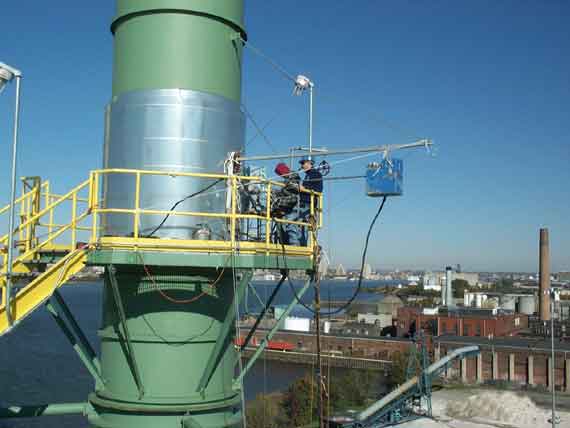The Consultant Stack Test Program is responsible
for the quality assurance of all stack emissions test
data in New Jersey. The goal of the program is to provide
reliable, accurate and dependable data to be used by
NJDEP, the public and industry.

EMS observes a consultant's procedures
in obtaining a representative sample of stack gases
on
a sampling platform 100 feet above ground level. Field
monitoring that sampling procedures
are consistent with approved protocol methods ensures
the accuracy of the results.
The Stack Test Process
When a facility is required to perform a stack emissions
test, either by their Permit, regulation or from an
enforcement action, oversight is provided by EMS. There
are three main elements to a stack emissions test program:
- Protocol review and approval
- Observation of the stack test.
- Review of the final test report.
In most cases, a test consultant is contracted to
prepare the protocol, perform the test and submit the
report.
Step One: The Protocol
The protocol is a source specific test plan that details
how the test will be performed. It identifies the test
methods that will be used, as well as how they will
be adapted to meet the source specific conditions. EMS
reviews the protocol to ensure that both the most appropriate
methods are proposed and that they are being applied
properly. Deficiencies are identified and must be corrected
before EMS will allow testing.
Step Two: Field Sampling
Once the protocol is approved and the test is scheduled,
the sampling is conducted with EMS oversight to ensure
adherence to the protocol. We believe test observation
is the most critical aspect of quality assuring emissions
test data. The manner in which an air sample is collected
can greatly influence the results. Many problems would
go undiscovered without direct observation by DEP personnel.
Step Three: The Final Report
In the final step, a test report is prepared and submitted
to EMS for evaluation. The report must include copies
of all raw field and laboratory data through which EMS
staff can ensure all procedures were adhered to and
so that EMS can confirm the calculations of the emissions
results.
For More information
For a more detailed explanation of how one goes about
conducting a stack test, please download
Technical Manual 1004,(in pdf
format), "Guidelines for Compliance Stack
Emission Test Programs".
To open the PDF documents you will
need the adobe acrobat pdf reader to view. Left-click
on the link and they will open. Or, right-click on the
link and select "Save Target As" to save the document
to your hard drive or personal directory. You can download
the free pdf reader here. |